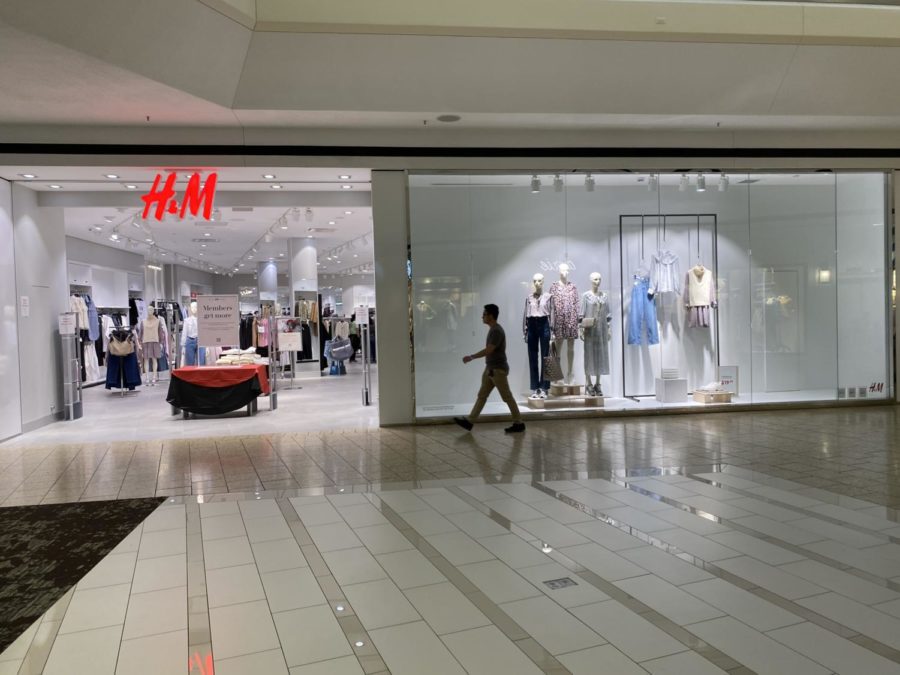Fast Fashion’s Eco Impact
H&M’s storefront at Fair Oaks Mall in Fairfax, VA. The UN Alliance for Sustainable Fashion says that the average consumer buys up to 60% more clothes than they did 15 years ago.
These days, trendy, cheap clothes are available at the tap of a button. That seems great for consumers, but is it really? H&M and other fast fashion stores, like SHEIN and Forever 21, aren’t as virtuous for the environment or their workers.
The Cambridge Dictionary defines fast fashion as “clothes that are made and sold cheaply, so that people can buy new clothes often.” Just one issue: the fast fashion industry is responsible for 8-10% of global greenhouse gas emissions, according to the UN Alliance for Sustainable Fashion. And, as the EPA reports, about 85% of all textiles in the US end up in landfills or are burned.
“Fast fashion is pretty bad, ethically speaking,” freshman Noah Nguyen said. “When you’re buying from places like SHEIN, it is bad quality clothes for dirt cheap. It seems like child labor, unpaid labor, or taking shortcuts with adverse effects on the environment is usually the only way distributors can make the clothes for that price. And when the clothes go out of style, they end up in landfills, which isn’t great.”
In 2021, it’s easier than ever to purchase clothes. The UN Alliance for Sustainable Fashion says that the average consumer buys up to 60% more clothes than they did 15 years ago. Tik-Tok and micro-trends are partly to blame. Micro-trends are smaller trends that rise in popularity in days or weeks- and fall even quicker. As of writing, sweater vests are hugely popular. On H&M’s website, the cheapest of the bunch is $12.99, and the most expensive is $39.99. In contrast, a hand-knit sweater from Etsy starts from $76.50. Instead of buying one sweater that will last a long time, consumers purchase multiple iterations from fast fashion stores that will end up in a Goodwill in six months.
That said, there’s no problem with experimenting. The issue is when it goes to excess. All over social media platforms like Tik-Tok, there are thousand-dollar SHEIN and Zara hauls where influencers share their latest purchases with eager followers. Micro-trends are featured on Tik-Tok’s elusive “for you page,” often shortened to FYP. And in no time, they are everywhere.
“Tik-Tok has a lot of trends that come and go, so people buy clothes more often, which is probably why fast fashion is a lot more popular now,” freshman Matipa Maimbo said. “It’s bad for the environment, but I can understand why people are buying it if it’s all they can afford.”
This raises a good point- what if Zara is all someone can pay for? ”It comes down to the corporations,” freshman Kate Nagler said. “Some of them could definitely afford to use better ethics practices, but they choose not to.”
This is undoubtedly the case for H&M- during the 2020 fiscal year, they made $334 million, according to Statista. However, Good On You, a site that rates clothing brands on their ethics, has rated H&M “it’s a start,” which is staunchly at the middle of its ranking system.
Although environmentalist efforts are gaining traction, there is still much progress to be made. H&M’s website states that the company has plans to use only “recycled or other sustainably sourced materials by 2030.” They’ve also started a recycling program, where customers can drop off their old clothes to be reused or recycled. According to Good On You, it uses recycled and eco-friendly materials some of the time and has a policy to prevent deforestation in its supply chain. H&M also has a science-based target to lower its greenhouse gas emissions, however, there is no current evidence that it is on track to meet the goal.
While The Guardian says there are only 100 companies that account for 71% of the world’s greenhouse gas emissions, there are things everyday people can do to help slow down climate change. For example, a good alternative to fast fashion is thrift shopping, which has increased in popularity in recent years. Whether it’s corporations or social media that contribute to fast fashion’s disastrous effects on the environment, it’s clear that there is a problem- it’s just unclear exactly how to solve it.



